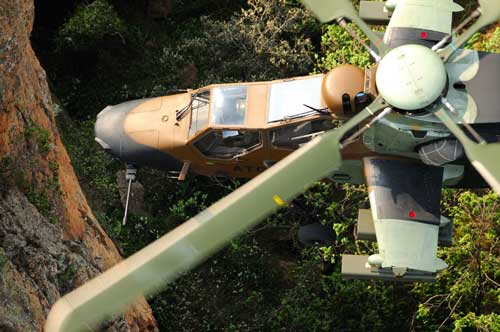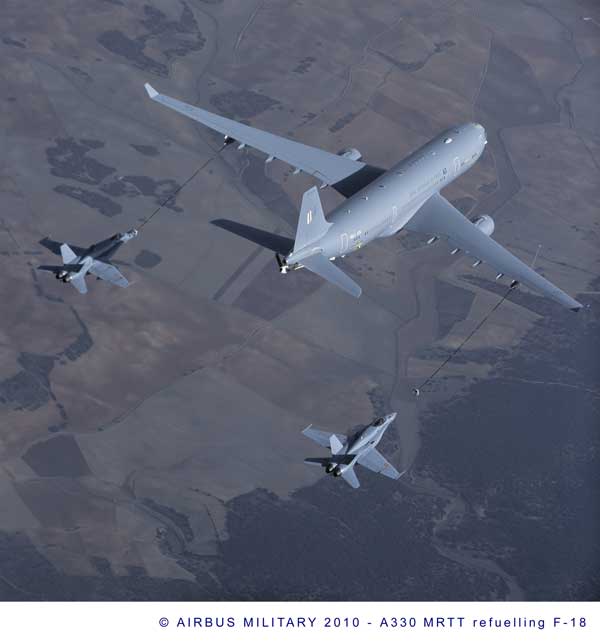06/27/2011 – In early June 2011, the Center for Strategic and International Studies (CSIS) released a comprehensive report on European countries’ defense industrial policies. Thus far, European governments have devoted sufficient resources to keep their deployed forces in a state of high readiness.
Often this has required special funding mechanisms such as supplementary appropriations kept separate from their countries’ regular defense budgets. Furthermore, since the size of most European national armed forces has decreased more rapidly than their governments have cut defense spending, the result has been that spending on the remaining military personnel has increased for the average individual soldier.
The combined effect of these two trends—a general per capita increase in spending and extra resources flowing to select deployable units—has been that some of their forces, particularly those regularly sent to Afghanistan, have received adequate training and equipment to develop the expeditionary capabilities needed by NATO and the EU for sustained post-conflict stabilization operations.
Unfortunately, these few military units represent the exception.
 The Franco-German Tiger helicopter is being used in both Libyan and Afghan missions. (Credit: Eurocopter)
The Franco-German Tiger helicopter is being used in both Libyan and Afghan missions. (Credit: Eurocopter)
For the most part, European governments have kept their other non-deployed forces at lower readiness levels. In addition, they have deferred many of their defense procurement and modernization programs. These funding and capability shortfalls have created major problems in unit readiness levels.
In the current Libyan campaign, many European militaries have experienced major shortages in precision-guided munitions and other essential equipment, ordnance, and other capabilities. The United States, which had been eager to limit its resource allocations to the Libyan War to prioritize the Afghanistan and Iraq conflicts, has been forced to fill these gaps.
Furthermore, whatever the per capita effects, Europe’s aggregate defense capacity has probably already declined due to decreased defense budgets and force levels. For example, the number of active duty military personnel in the 37 European countries studied (not all were NATO members) declined from 3.5 million in 2001 to about 2.3 million in 2009.
Finally, although the CSIS Defense Industrial Initiatives Group found that many European have protected their defense budgets during the last few years from the most severe cuts—often because of commitments to NATO, industrial policy considerations, or contractual obligations—they anticipate that this shielding will end as European countries experience major structural economic problems in the next decade. These macroeconomic challenges will include slow growth, high unemployment, enormous fiscal deficits, and an increase in the ratio of retired pensioners to taxpaying workers.
At some point, defense budgets could be squeezed further. Presuming military personnel levels stabilize, the result will be declining per capita spending on soldiers and a decrease in their ability to contribute to the most likely NATO missions, which will involve expeditionary rather than territorial defense operations.
The deep defense budget cuts adopted by many NATO members recently, which came on top of years of insufficient military spending, call into question whether NATO can maintain and develop the expanding defense capabilities called for by the 2010 Strategic Concept, which lists a growing range of security challenges requiring an Allied response.
The November 2010 Summit in Lisbon that adopted the Concept also adopted a so-called Lisbon package of priority capability needs—ranging from missile and cyber defenses to enhanced protection against improvised explosive devices in Afghanistan—aim to bolster the Alliance’s ability to address global threats.
For example, NATO’s newly expanded cyber mission will require significant, accelerated, and efficient modernization among alliance members to guarantee security across communications, military, and energy networks. In addition, the cost of developing and deploying the NATO-wide system to protect their populations from missile attacks from Iran and other neighboring regions may prove uncertain given that equally important projects are already encountering funding difficulties.
Furthermore, sustaining NATO’s nuclear capabilities will require the Alliance to maintain a means to deliver those nuclear weapons it does decide to retain. Europeans’ fleet of expensive dual-capable aircraft capable of dropping U.S. nuclear bombs has reached the end of their operational life and must now be replaced with new delivery systems.
 Europeans are adding new power projection capabilities such as the A330MRTT. Credit: Airbus Military)
Europeans are adding new power projection capabilities such as the A330MRTT. Credit: Airbus Military)
The best hope for keeping transatlantic capabilities somewhat in harmony would be for there to be greater defense specialization on select military acquisitions by country, increased multinational cooperation in procuring and using military capabilities, and a commitment by NATO governments to concentrate their remaining resources on developing smaller, more expeditionary-capable forces. These steps would best ensure that NATO’s collective capabilities more closely match the sum of its individual members’ contributions.
Optimists hope that the downward pressure on military spending will force European governments to take long-needed measures to reduce procurement duplication and pursue greater military specialization and interoperability. NATO and EU leaders have cited the cost pressure as giving them an opportunity as well as an imperative to secure more military value for defense spending through such measures as reducing unwanted defense duplication, reallocating resources based on collective rather than national priorities, encouraging more national military specialization on niche capabilities, as well as pursuing more collaborative research, development and procurement based on common funding mechanisms.
In some cases, NATO can act as a force multiplier, allowing members to contribute to expensive projects that they could not have afforded to pursue on their own. NATO has achieved some success in such collective defense capability initiatives, such as in the case of the Strategic Airlift Initiative and the Allied Ground Surveillance System. NATO Secretary-General Rasmussen and others have cited the timeshare operations for C-17 transport aircraft based in Hungary as a worthy example of emulation.
Unfortunately, pessimists can point to enduring obstacles to enhanced European defense industrial coherence, and wonder if progress will come soon, or prove sufficiently widespread, to have much of an impact on their military capabilities. Industrial policy concerns such as sustaining domestic employment as well as a natural national reluctance to rely on other countries for military important capabilities typically exert much more influence on NATO or EU spending than collective security considerations.
For this reason, proposals to extend NATO- or EU-wide defense procurement have never made much progress. NATO defense investment continues to be diluted across an excessive number of projects, with the most important military powers seeking to sustain national aviation, shipbuilding, and information technology sectors despite the resulting duplication, inefficiencies, and insufficient economies of scale.
The key question is whether Europe’s most important military powers pursue similar policies. The United Kingdom, France, and Germany represent about 65 percent of all defense expenditure in Europe and 88 percent of all military research and development in Europe.
Most other allies can only make small or niche contributions to expeditionary missions, while still requires that they keep defense spending sufficiently high to permit their military personnel of valuable potential training opportunities.
Despite budgetary strains, their governments are still planning to retain major expeditionary military capabilities—having the ability to deploy some 10,000 to 30,000 troops within a few months on a multi-month mission—for the next few years.
But the end of the Afghanistan mission around 2014 combined with probable future demographic trends such as expected rises in welfare spending and other fiscal pressures will likely result in further reductions over time in force levels, military readiness, and defense procurements.
Even in European countries with large aggregate defense budgets such as Germany, spending is not optimized to NATO’s expanding international security obligations since money flows predominately to manpower and maintenance rather than researching, developing or procuring new weapons systems.
Most European militaries still spend excessively on capabilities related to territorial defense rather than for meeting global challenges through expeditionary forces. Of the two million European active duty forces, only 3-5% of them are readily deployable and sustainable at strategic distances from Europe in complex contingencies such as on stabilization or counter-piracy or peacekeeping missions. These deployments address emerging threats that directly affect Europeans’ interests if not necessarily their national frontiers.
There are several examples of how NATO countries have been able to develop the dynamic and flexible forces the Alliance needs to address these threats rather than legacy forces that suck up funds but provide relatively little defense capability. Belgium, Canada, Denmark, and Norway have all been able to make important contributions to the NATO operation in Libya despite their limited defense spending because they have concentrated their resources on developing expeditionary capabilities such as strike aircraft.
Furthermore, NATO can save money collectively by reducing the size and rationalizing the management of the Alliance’s numerous commands, defense agencies, and other support structures and processes. The November 2010 Lisbon Summit endorsed proposals to make NATO’s new command structure more effective and flexible—specifically by making these structures more easily deployable outside the Euro-Atlantic area. At the summit, NATO committed to adopting a new, streamlined Command Structure, which should reduce costs by around 35%. Such a move will reduce the number of high-end headquarters from eleven to seven, and reduce military personnel by about a third. The number of NATO agencies is set to fall from fourteen to three in an effort to achieve greater efficiency.
But NATO leaders deferred for further discussion and decision the question of which specific cuts to make—the individual Allies can be expected to bargain hard to retain their share of these dwindling assets. How much integration can be achieved in NATO’s administration and logistics support functions, and with what effects, is also uncertain. Even if these changes in NATO’s support structures and processes are extensive, the history of almost all modern defense organizational reforms suggests that realizing massive financial savings or huge efficiency gains is improbable. The appropriate capabilities—and even strategy and tactics—required to fulfill the new NATO missions, such as ensuring members’ cyber and energy security, has only begun to be studied.
The NATO organization could still assist the defense cooperation initiatives of its individual members by improving its long-term force planning processes to ensure better coherence and integration among Allies’ future defense programs, especially for the less visible so-called out-year forces whose procurement will occur at least six years beyond the current budgetary cycle. This could also allow NATO members, including the United States, to develop complementary future capabilities that avoid gaps and exploit synergies.
Some of this is already occurring through existing alliance-wide processes as well as initiatives among a few NATO members. For example, the 2010 British-French treaties has led both countries to consider how to ensure that their various naval capabilities are complementary. The Visegrad Group, the Weimar Group, and the Nordic countries are also engaging in more pooling, sharing, and integrated defense planning. But the procedure needs to be extended to cover more capabilities and countries, including the United States, which has many defense programs that proceed largely independent of NATO.
The NATO Group of Experts that helped write the Strategic Concept cautioned in their May 2010 report that the transatlantic capabilities gap “could undermine Alliance cohesion.” The United States spends almost five percent on its GDP on defense when one includes the supplemental expenditures relating to the wars in Iraq and Afghanistan. Even after the latest round of budget cuts, Britain will still spend more than two per cent of its GDP on defense, and retain the ability to surge forces into distant theaters of war. But many other European governments have been keeping military expenditures to minimum levels well before their recent austerity reductions. In 2009, only five out of 28 NATO members met NATO’s requirement that they spend at least two percent of national GDP on defense.
Achieving a global capability, and sustaining domestic political support for the transatlantic alliance in Washington, requires that the European Allies have some capabilities that they can commit to non-European missions.

